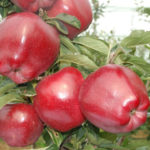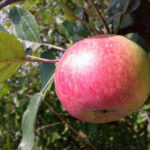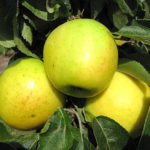Apple variety Chervonets (columnar)
Having a real apple orchard on a tiny plot is not a dream at all, but a reality realized thanks to the joint efforts of nature and breeders. We are talking about columnar apple trees, which, although with some caution, still become full-fledged inhabitants of many Russian gardens, adding decorativeness and aesthetics to them. Among the popular varieties is Chervonets (aka KB82), created by Professor V.V. Kichina and N.G. Morozova in 1983. The new variety was obtained with the help of I.V. Michurin method of hybridization. The initial forms were: the American donor of scab resistance SR0523, obtained by complex crossing Red Melba and a hybrid (Wolf River x M. atro sangujnea, 804), and the first columnar apple tree Vazhak. In 1990, seedlings were selected, which from 1996 began to multiply under the name Chervonets. In 2005, an application was submitted for registration of the novelty in the State Register of Breeding Achievements of Russia, which took place in 2008. The admission region is Central (Bryansk, Vladimir, Ivanovsk, Ryazan, Kaluga, Moscow, Tula and Smolensk regions). The applicant and originator of the novelty is the All-Russian Institute of Selection and Technology of Horticulture and Nursery.

Description
The plant has good vigor. Refers to semi-dwarfs. The tree is compact, medium-sized, about 2 meters high. Shoots are short, tough, attached to the stem at an acute angle (while the wood connection is quite strong). Appressed shoots form a thin columnar-shaped crown. The internodes are short. The trunk of an apple tree has a girth of 50 cm, quite strong, densely overgrown with fruit formations. Sufficient leafiness. The leaves are rich green, rather large, broadly ovate with a twisted helical top. The base of the leaf blade is rounded, the surface is slightly shiny. The petiole is of medium length and thickness.
One of the advantages of the variety is its large-fruited, the mass of an apple, according to the State Register, is 180 grams. But this is far from the maximum, because an adult culture, with proper care, can easily form fruits weighing 200, and even 250 grams. According to some reports, the maximum weight of the fetus is about 350 grams. Outwardly, apples are very attractive. Fruits are of medium one-dimensionality, round in shape. The skin is dense, shiny. The main color is light yellow, the integumentary color is in the form of a bright crimson-red blush, which often occupies a large surface of the fruit. It is for the appearance of the fruits, which are distinguished by their rounded shapes and rich red color, that the apple tree got its name. The pulp is white, in the period of consumer maturity it has a light creamy shade, dense consistency, fine-grained, very juicy. The aroma, though not very pronounced, is very pleasant. The taste is very good, dessert type, sweet and sour, rather even closer to sweet. The assessment of tasters given by the State Register is 4.3 points.
Characteristics
- Like all columnar varieties, Chervonets has a very good early maturity. Already 2 - 3 years after planting, the first crop appears. And from the fifth year, full-fledged fruiting begins;
- in terms of ripening, the variety belongs to the autumn. The harvest period falls at the end of September. The consumer period begins at the same time - at the end of September. Experienced gardeners recommend not delaying harvesting, as overripe pulp loses its density and becomes slightly wadded;
- the yield is stable and high. The productivity of one tree is 6 - 8 kg. According to the State Register, over the years of variety testing, the average yield was 1200 c / ha. The food area in the columnar gardens is 1.0 mx 0.5 m;
- to maintain high productivity, the apple tree needs re-pollination;
- the life expectancy of our hero is quite long, he may well live 50 years. But the productive period lasts only 15 - 17 years, after which the tree is recommended to be replaced;
- the flowering strength of a variety depends on how cold the winter was. So, in 2005 - 2006, when the temperature in mid-January dropped to -36 ° С, the strength of flowering on a one-year growth was estimated at 2 points out of 5 possible;
- fruits are of high commercial quality, almost the entire crop is classified as extra class, which allows our hero to compete with the best varieties;
- in terms of winter hardiness, Chervonets can be safely compared with an apple tree Melba... That is, the ability of a culture to withstand a complex of unfavorable factors in the winter period is assessed as medium-high. The degree of freezing in severe winters does not exceed 1 - 2 points;
- the State Register does not provide data on immunity. In Internet sources, you can find information that the variety has field resistance to scab due to the Vm gene. However, there is information that in the most unfavorable years the apple tree can be affected by a fungus, while the maximum recorded damage was not higher than 2.0 points;
- the crop withstands transportation well. The keeping quality is also good. Apples can be stored for two to three months;
- the way of use is universal. The attractive and tasty apples are primarily used in their natural form. Also, the harvest perfectly withstands all types of culinary processing, therefore, if desired, many tasty and healthy preparations can be prepared from the fruits of this variety.
Planting and leaving
The optimal time for planting Chervonets in the Central region is spring, the period from the first ten days of April to May 1. But the plant will also tolerate autumn planting well if it is planted 2 - 3 weeks before the onset of stable cold weather. Choose a place for planting in well-lit, level areas. Lowlands should be avoided, where there is excessive soil moisture and cold air stagnates. Loose, structured, air and mineral permeable soils are preferable. On heavy clay soils, a planting pit should be prepared in advance, at the bottom of which a drainage layer is laid and filled with a suitable soil mixture. In general, the agricultural technology of columnar apple trees is no different from ordinary ones. They also need watering as needed and taking into account natural precipitation or elevated air temperatures. Root top dressing must be combined with foliar dressing, but in this case, the fertilizer concentration is halved. Despite the columnar crown, the variety needs proper pruning.
The rootstocks have a great influence on the early maturity and productivity of our hero. So, for example, on a super-dwarf rootstock, a culture in the first year of fruiting is able to show a significantly larger yield than on a zoned M9. Vigorous rootstocks are not recommended, as lateral branches begin to grow strongly on them. Mark and 62-396 are considered the most suitable, except for M9.
Chervonets is the most suitable solution for planning a garden in a small area. Slender trees will look spectacular along the path or fence, they can serve as a natural screen separating the recreation area from the garden. And for cross-pollination, you can plant several varieties with the same flowering period. In addition to aesthetic pleasure, our hero is able to show good productivity, and his fruits will be not only beautiful, but also very tasty. Taking care of the crop is easy, as well as harvesting, which children will be happy to do. In the Central region, winter hardiness is quite sufficient, but young seedlings still need to be insulated. This apple tree is considered one of the most successful varieties for the Moscow region. Over the years of cultivation, no significant shortcomings have been identified.








